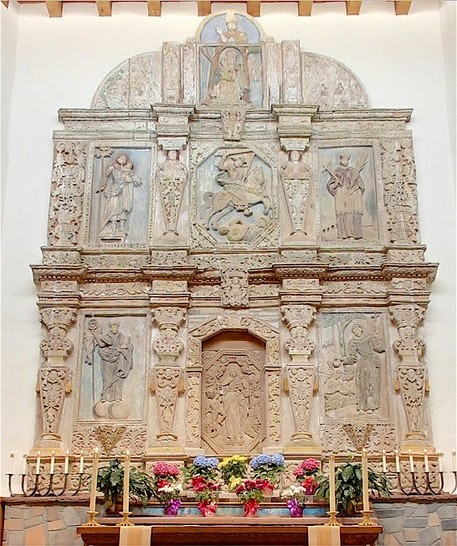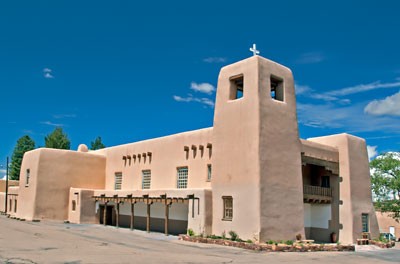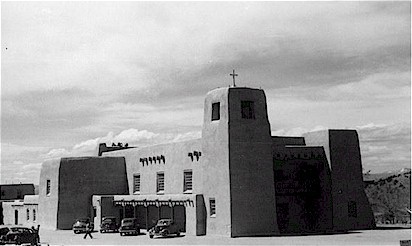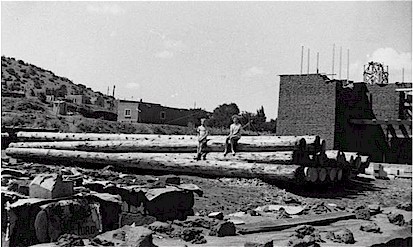Cristo Rey Catholic Church and Reredos of Our Lady of Light
Introduction
Text-to-speech Audio
Images
The Grand Reredos of Our Lady of Light

The Reredos' Current Home: The Cristo Rey Catholic Church

Blast from the Past: The Cristo Rey Catholic Church

Blast from the Past: The Construction of Cristo Rey Catholic Church (around 1939)

Backstory and Context
Text-to-speech Audio
In 1760, New Mexican governor, Fransisco Antonio Marín de Valle built a military chaplain in the south side of the present day Santa Fe Plaza, and he called it Our Lady fo Light; sometimes it was also referred as La Cantranse ("the military"). Marín de Valle was said to have been one of the founding members of Our Lady of Light, which is a religious society connected with the chaplain. Marín de Valle brought in two masons from Zacatecas, Mexico to build a commemorative stone piece for the new chaplain. The masons made a reredos, which is typically a large altarpiece or decoration that is placed in the back of the altar. The reredos is recorded to be 25 ft. high and 18 ft. wide, and it was made from soft, white volcanic rock that come from Pojoaque, New Mexico. Within the reredos, there are several Catholic imagery and figures etched into the stone, such as God, baby Jesus, Our Lady of Valvanera, angels, and several saints. In addition, the reredos also included reliefs, which are details, figures, and ornaments in stonework or metalwork that are projected, outlined, raised, and/or distinguishable from their background. One of the most notable etchings of the reredos is the image of Our Lady of Light saving baby Jesus from Satan.
Throughout the chaplain's early history, there have been several historical and religious figures have visited the chaplain, such as the Bishop of Durango Pedro Tamarón y Romeral, Fray Atanasio Domínguez, and New Mexican governor Manuel Armijo. All of them admired the beautiful interior of the chaplain and the reredos. At the time of the chaplain's construction and when it was used for religious services, the Mexican government financially supported military chaplains in the southwestern region of the U.S. However, the Mexican government pulled their support from Our Lady of Light and other military chaplains. Our Lady of Light was eventually abandoned and fell into despair. In 1846, when the US army occupied the area, they discovered the church and its severely dilapidated appearance. Accounts have said that the roof collapsed. The soldiers in the area eventually renovated the chaplain, and they converted the chaplain into a storehouse.
In 1859, the reredos was relocated to La Parroquia, which was the main parish church of Santa Fe located at the present day St. Francis Cathedral. The reredos was kept away from common view, and it was hidden in a small room behind the church's altar. Cristo Rey Catholic Church was completed in 1939 and the reredos was installed in the church's sanctuary. Built by famous Santa Fe architect, John Gaw Meem IV, the Cristo Rey Catholic Church is considered to be one of the most beautiful examples of the Pueblo Revival architectural style in the United States. Measuring at 125 ft. long, 33 ft. tall, and 40 ft. wide, many have said the church is the largest adobe structure in the United States. In 1970, the reredos was listed on the National Register of Historic Places for its historical and artistic significance. Many have said the reredos' size, composition, cravings, and excellent condition are what make it one of the one of the most extraordinary pieces of ecclesiastical art in the country. The reredos is still housed in the Cristo Rey Catholic Church. Located at the altar, patrons of the church can see the reredos' full beauty while attending Mass and participating in confessionals.
Sources
"Bishop Tamaro's Visitation to New Mexico, 1760," New Mexico History. July 22nd 2015. Accessed July 17th 2020. http://newmexicohistory.org/2015/07/22/bishop-tamarons-visitation-to-new-mexico-1760/.
Cristo Rey Catholic Church. n.d. Accessed July 17th 2020. http://cristoreyparish.org.
Larcombe, Samuel. "Reredos of Our Lady of Light," National Register of Historic Places. June 3rd 1970. Accessed July 17th 2020. https://npgallery.nps.gov/NRHP/GetAsset/NRHP/70000411_text.
http://cristoreyparish.org/photo-history.htm
https://noehill.com/nm_santafe/nat1970000411.asp#:~:text=Reredos%20of%20Our%20Lady%20of%20Light%20in%20Cristo,from%20the%20Spanish%20period%20in%20the%20United%20States.
http://cristoreyparish.org/photo-history.htm
http://cristoreyparish.org/photo-history.htm
